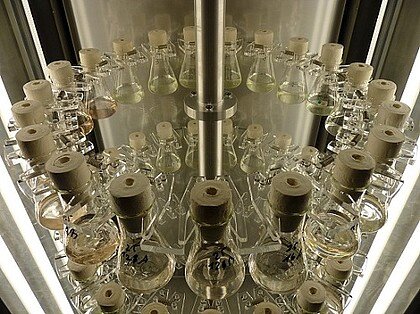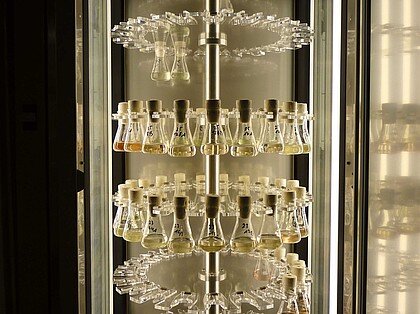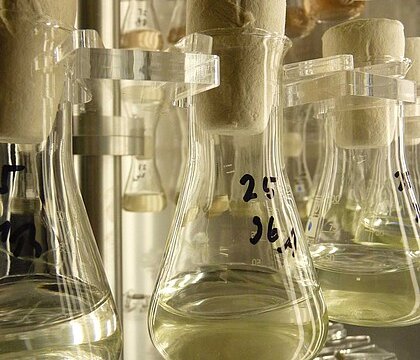
Freshwater Algae and Cyanobacteria, Growth Inhibition Test
OECD 201, 2006
Principle
The purpose of this test is to determine the effects of a substance on the growth of freshwater microalgae and/or cyanobacteria, which play an important role as primary producers in aquatic systems. Exponentially growing test organisms are exposed to the test substance in batch cultures over a period of normally 72 h. In spite of the relatively brief test duration, effects over several generations can be assessed.
Study design
The test organisms are exposed to a dilution series of the test substance within the relevant concentration range (derived from a range finding pre-test) and incubated under defined light and temperature conditions for 72 h. Three replicates for each test concentration and six control replicates without test substance are studied in parallel. Several species of non-attached microalgae and cyanobacteria may be used for this test (e.g. Desmodesmus subspicatus, Raphidocelis subcapitata). Growth of the test organisms is analysed after 24, 48 and 72 h incubation by measuring a surrogate parameter for biomass, such as cell counts, fluorescence, optical density etc. The test endpoint, inhibition of growth, is calculated by comparing the logarithmic increase in biomass during the exposure period (average specific growth rate) for each test concentration with growth rate in the control batch. Dose-effect relationships are calculated by means of regression analysis with log-probit-transformation of the resulting parameter pairs, and from this the 50% effect concentration regarding growth (ErC50) is determined. In addition, the 50% effect concentration of the yield (biomass at the end of the exposure period minus the biomass at the start of the exposure period) and the lowest observed effect concentration (LOEC) and the no observed effect concentration (NOEC) are statistically determined.

Fresh water algal growth inhibition test with unicellular green algae
ISO 8692
Principle
The purpose of this test is to determine the effects of a test substance or environmental samples on the growth of freshwater green algae. These algae play a very important role as primary producers in aquatic systems. Exponentially growing green algae are exposed to the test substance or environmental sample over a period of 72h and inhibition of growth is analysed. In spite of the relatively brief test duration, effects over several generations can be assessed.
Study design
The planktonic freshwater algae species Desmodesmus subspicatus or Raphidocelis subcapitata (former name: Pseudokirchneriella subcapitata) are exposed to a dilution series of the test substance or environmental sample and incubated under defined light and temperature conditions for 72 h. Three replicates for each test concentration and six control replicates without test substance are studied in parallel. Growth of the algae is analysed after 24, 48 and 72 h incubation by measuring a surrogate parameter for biomass, such as cell counts, fluorescence, optical density etc. The test endpoint, inhibition of growth, is calculated by comparing the logarithmic increase in biomass during the exposure period (average specific growth rate) for each test concentration with the growth rate in the control batch. Dose-effect relationships are calculated by means of regression analysis and from this the 50% effect concentration regarding growth (ErC50) is determined. When testing waste water by means of a graduated dilution, the test medium with the highest concentration at which an inhibition <5% is observed is termed the lowest ineffective dilution (LID) and reported as final result of the test.

Determining the tolerance of green algae to the toxicity of waste water
DIN 38412-33
Principle
Toxic effects of water constituents and waste water on the green algae Desmodesmus subspicatus are determined over a period of 72h.
Study design
The planktonic freshwater algae species Desmodesmus subspicatus is exposed to a dilution series of a waste water sample and incubated under defined light and temperature conditions for 72 h. Two replicates for each dilution, three negative control replicates and three positive control replicates with addition of a reference substance are studied in parallel. The cell density is measured at the beginning and at the end of the exposure period by fluorescence measurements. As test result, the lowest dilution D is reported at which an inhibition <20% is measured (=LID, lowest ineffective dilution).

